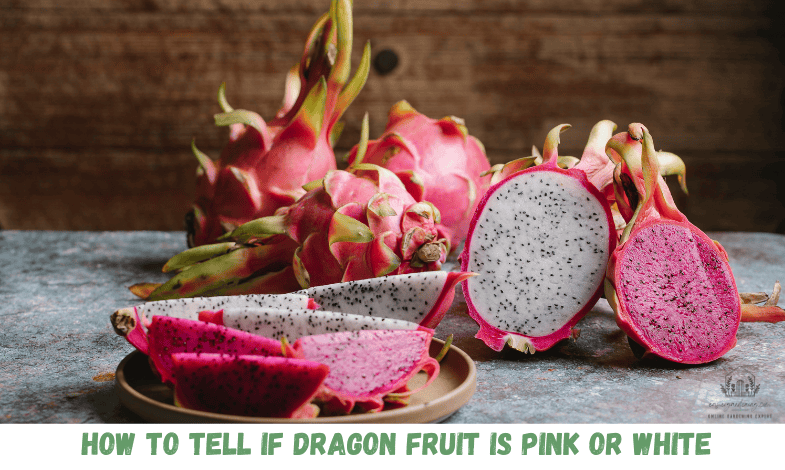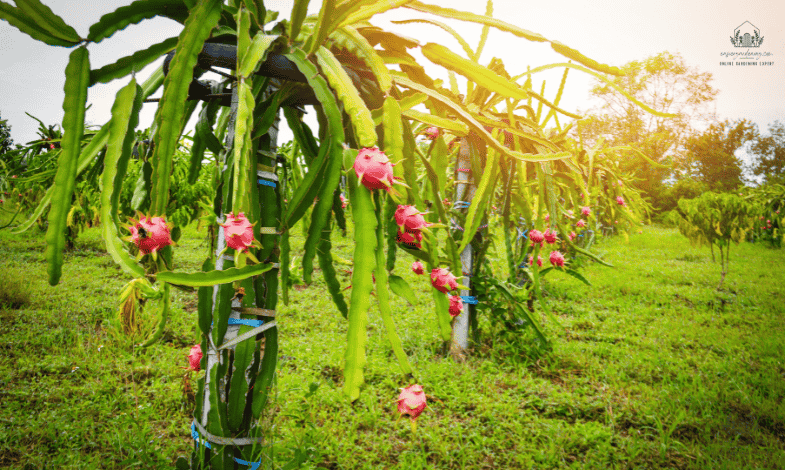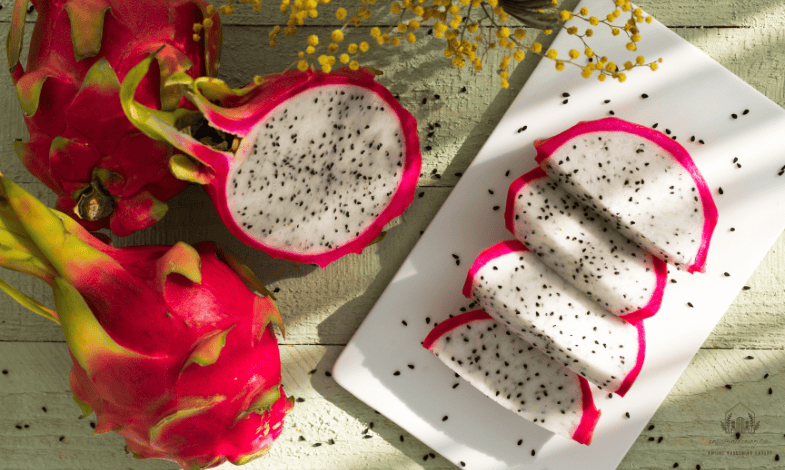Did you know that over 60% of dragon fruit enthusiasts can’t distinguish between pink and white varieties at first glance? We’ve been there, staring at a pile of dragon fruits, wondering if we are about to bite into a vibrant pink or a subtle white interior. It’s like a fruity game of Russian roulette! But fear not, fellow fruit lovers. We have cracked the code and are here to share our secrets.
Contents
- Spotting a Ripe Dragon Fruit
- Look for These Signs
- Feel for Ripeness
- Different Types of Dragon Fruit
- Red Skin with White Flesh
- Red Skin with Red Flesh
- Yellow Skin with White Flesh
- Nutritional Value of Dragon Fruit
- Water Content in Dragon Fruit
- Energy Content of Dragon Fruit
- Fatty Acid Composition
- When to Enjoy Dragon Fruit
- Best Time to Pick Dragon Fruit
- Ripening at Home
- Popular Dragon Fruit Varieties
- American Beauty
- Cosmic Charlie
- Asunta 4
- Halley’s Comet
- Taste Comparison
- Sweetness Levels
- Flavor Profiles
- Seed Characteristics
- Edibility of Seeds
- Seed Appearance
- Keeping Dragon Fruit Fresh and Tasty
- Refrigeration Tips
- Shelf Life After Cutting
Spotting a Ripe Dragon Fruit
Want to savour a dragon fruit at its best? Here’s how to tell if it’s ripe and ready to eat. Let’s break it down with some simple tips and tricks.
Look for These Signs
When it comes to dragon fruit, your eyes can tell you a lot.
- Colour: A ripe dragon fruit has a bright, even colour. Red-skinned ones should be a vivid pink or red, while yellow-skinned types should be a deep yellow. Steer clear of fruits with wrinkled skin or lots of blemishes.
- Leaf Tips: The leaves (or “bracts”) sticking out from the fruit should look wilted but not completely dried. This is a good sign that the fruit is ripe.
- Skin Feel: Gently press the skin. It should give a little but not feel mushy. If it’s too soft, it’s probably overripe (Made In Cookware).
Feel for Ripeness
Beyond looks, the texture can also clue you in.
- Firmness: A ripe dragon fruit should yield slightly when you squeeze it. If it feels mushy, it’s past its prime and might not taste as good.
- Skin Thickness: Dragon fruit skin is thick, so you’ll need a good knife to cut through it (Made In Cookware). This doesn’t change much with ripeness, but a ripe fruit might be easier to slice.
By watching these signs, you can pick a dragon fruit that’s just right. For more tips on handling dragon fruit, check out our articles on keeping it fresh and how long it takes to grow.
| Indicator | Ripe Dragon Fruit | Overripe Dragon Fruit |
|---|---|---|
| Colour | Bright pink/red or rich yellow | Wrinkled skin, visible blemishes |
| Leaf Tips | Slightly wilted | Completely dried out |
| Skin Feel | Slightly flexible | Mushy |
| Firmness | Gives slightly under pressure | Overly soft |
With these tips, you’ll be able to enjoy dragon fruit at its best, bursting with flavour and packed with nutrients.
Different Types of Dragon Fruit
Dragon fruit, or pitaya, has three main types: red skin with white flesh, red skin with red flesh, and yellow skin with white flesh. Each has unique traits that make it stand out.
Red Skin with White Flesh
This is the most common type. The bright red skin and juicy white flesh, dotted with tiny black seeds, make it easy to spot. To check if it’s ripe, look for bright pink skin that’s slightly soft but not mushy (wikiHow).
| Attribute | Description |
|---|---|
| Skin Color | Bright red or pink |
| Flesh Color | White |
| Seed Color | Black |
| Common Uses | Smoothies, salads, and eating fresh |
Red Skin with Red Flesh
This variety is a bit more vibrant and sweet than its white-fleshed cousin. The same ripeness rules apply to bright skin and a soft feel when gently squeezed (Made In Cookware).
| Attribute | Description |
|---|---|
| Skin Color | Bright red or pink |
| Flesh Color | Red or magenta |
| Seed Color | Black |
| Common Uses | Desserts, juices, eating fresh |
Yellow Skin with White Flesh
Less common but highly prized, this variety stands out with its yellow skin and juicy white flesh dotted with black seeds. Ripe yellow dragon fruit will also be slightly soft to the touch (Made In Cookware).
| Attribute | Description |
|---|---|
| Skin Color | Bright yellow |
| Flesh Color | White |
| Seed Color | Black |
| Common Uses | Salads, snacking, garnishes |
Each type of dragon fruit has its charm and uses. Knowing how to tell them apart can make gardening and cooking fun whether you’re drawn to their looks or flavours. For more tips on handling and storing dragon fruit, check out our guide on how to keep dragon fruit fresh.
Nutritional Value of Dragon Fruit
Dragon fruit, or pitaya, isn’t just a pretty face; it’s a nutritional powerhouse. Let’s break down its goodies, focusing on hydration, energy, and fats.
Water Content in Dragon Fruit
Dragon fruit is like nature’s water bottle. It’s super hydrating because it’s mostly water.
| Nutrient | Amount per 100g |
|---|---|
| Water | 87g |
87 grams out of every 100 grams of dragon fruit is water. This makes it a great choice to keep you refreshed and healthy.
Energy Content of Dragon Fruit
Are you worried about calories? Don’t be. Dragon fruit is low in calories but high in nutrition.
| Measure | Kilojoules | Kilocalories |
|---|---|---|
| 100 grams | 240 kJ | 57 kcal |
This snack is guilt-free and tasty with just 57 kilocalories per 100 grams. It’s also a great way to stay on track with your diet.
Fatty Acid Composition
Dragon fruit isn’t a fat bomb, but it does have some good fats that your body needs.
| Nutrient | Amount per 100g |
|---|---|
| Total Fat | 0.1g |
| Saturated Fat | 0.0g |
| Monounsaturated Fat | 0.0g |
| Polyunsaturated Fat | 0.1g |
The fat content is minimal, but the little bit of polyunsaturated fat it has is good for you. It’s a win-win for anyone watching their fat intake.
Check out our other articles for more tips on keeping dragon fruit fresh and how long it takes to grow.
When to Enjoy Dragon Fruit
Getting the timing right for dragon fruit is like hitting the jackpot. Let’s break down when to pick this tropical gem and how to make sure it’s just suitable for eating.
Best Time to Pick Dragon Fruit
Dragon fruit loves the summer sun and early fall breezes. That’s when it’s at its sweetest and juiciest. So, if you want to get the best out of your dragon fruit, aim for these months.
To know if it’s ready, check for:
- Bright pink skin
- A little give when you press it
Steer clear of ones with wrinkly skin or spots—they’re past their prime.
Ripening at Home
Don’t sweat it, even if you grab one that’s not quite ready. Dragon fruit keeps ripening after it’s picked. Leave it on the counter for a few days, and it’ll sweeten up nicely.
Here’s a quick guide:
| Stage | What to Look For | What to Do |
|---|---|---|
| Not Ready | Firm, dull color | Leave it out |
| Just Right | Bright pink, a bit soft | Dig in! |
| Too Late | Wrinkly, spotted | Eat ASAP or toss it |
Knowing how to handle dragon fruit means enjoying it at its best. For more tips on keeping it fresh, check out our guide on storing dragon fruit.
You can enjoy dragon fruit’s unique taste all season by picking it at the right time and letting it ripen properly. And if you’re into gardening, why not try growing your own? Check out our tips on increasing mandarin orange seeds or saving banana pepper seeds. Happy gardening!
Popular Dragon Fruit Varieties
Growing dragon fruit? You’re in for a treat! Let’s check out some of the top varieties that gardeners rave about.
American Beauty
Meet the American Beauty dragon fruit, also known as Hylocereus guatemalensis. This pink-skinned beauty has sweet, juicy flesh and hails from Central America. It usually fruits in the summer and fall, making it a seasonal delight. Gardeners love its vibrant colour and delightful taste.
| Variety | Skin Color | Flesh Color | Season |
|---|---|---|---|
| American Beauty | Bright Pink | Pink | Summer/Fall |
Cosmic Charlie
Cosmic Charlie is a hybrid between H. guatemalensis and H. undatus. This variety is famous for its exceptional sweetness, with flavours that mix berry and pear notes. If you love a fruity, nuanced taste, it has red skin, green scales, and a pink interior with tiny seeds.
| Variety | Skin Color | Flesh Color | Flavor Notes |
|---|---|---|---|
| Cosmic Charlie | Red with Green Scales | Pink | Berry and Pear |
Asunta 4
Asunta 4 is a hybrid of H. stenopterus and H. guatemalensis. It sports a pink exterior and a white interior with black seeds. Its flavour is a unique blend of sweetness and a slight tanginess. Gardeners appreciate its distinctive taste and striking look.
| Variety | Skin Color | Flesh Color | Flavor Notes |
|---|---|---|---|
| Asunta 4 | Pink | White | Sweet with Tanginess |
Halley’s Comet
Halley’s Comet is a cross between H. undatus and H. guatemalensis. Known for its large size, bright pink skin, and juicy red interior, this variety is delightful and perfect for desserts and beverages. Its vibrant colour and sweetness make it stand out in any garden.
| Variety | Skin Color | Flesh Color | Uses |
|---|---|---|---|
| Halley’s Comet | Bright Pink | Red | Desserts and Beverages |
Understanding these popular dragon fruit varieties helps you pick the right one for your garden. Whether you’re into the sweet and juicy American Beauty or the large and vibrant Halley’s Comet, there’s a variety that will fit your needs. For more tips on growing dragon fruit, check out our articles on how long to grow and how to keep dragon fruit fresh.
Taste Comparison
Trying to figure out the difference between pink and white dragon fruit? Let’s break it down and see what makes each one unique.
Sweetness Levels
Dragon fruit sweetness can vary quite a bit. Here’s a quick look at how they stack up:
| Dragon Fruit Type | Sugar Content | Sweetness Level |
|---|---|---|
| Red Skin with White Flesh | Moderate | Mild to Moderate |
| Red Skin with Red Flesh | High | Sweet |
| Yellow Skin with White Flesh | High | Very Sweet |
According to Seeds Del Mundo, red dragon fruit (red skin with red flesh) is sweeter and juicier than white. The red one packs more sugar, making it sweeter. Conversely, white dragon fruit has a gentler flavour and light sweetness.
Flavor Profiles
The flavours of dragon fruits also set them apart. Here’s the scoop:
Red Skin with White Flesh:
- Flavor: Mild sweetness with a hint of nuttiness.
- Texture: Firm and crunchy.
- Notes: This one’s got a subtle taste, which is excellent if you like something less intense.
Red Skin with Red Flesh:
- Flavour: Sweet with refreshing notes and a touch of acidity.
- Texture: Juicy and tender.
- Notes: The bright red flesh signals a rich, sweet taste and more antioxidants.
Yellow Skin with White Flesh:
- Flavor: Very sweet with a smooth texture.
- Texture: Juicy and soft.
- Notes: Known for being the sweetest of the bunch.
Red-fleshed dragon fruit isn’t just sweeter; it also has more antioxidants than the white-fleshed kind (Seeds Del Mundo). So, the red one might be your go-to if you’re after flavour and nutrition.
Want to know how to keep your dragon fruit fresh? Check out our guide on how to keep dragon fruit fresh. Knowing these taste differences can help you pick the perfect dragon fruit for your taste buds and recipes.
Seed Characteristics
Dragon fruit seeds are more than just tiny black specks; they’re a crunchy, nutritious part of this exotic fruit. Let’s break down what makes these seeds unique.
Edibility of Seeds
Dragon fruit seeds are small, black, and edible. Think of them like kiwi seeds—tiny, crunchy, and packed with goodness. The seeds stay the same whether the flesh is red, white, or pink (Seeds Del Mundo). They add a slight crunch and are loaded with nutrients.
Wondering about the health benefits? These seeds are rich in fatty acids like omega-3 and omega-6, which are great for your heart. They also have protein and fiber, making them a healthy snack.
Seed Appearance
Dragon fruit seeds look the same across all varieties. They’re tiny, black, and scattered throughout the flesh. The seeds stand out whether the flesh is white, hot pink, or deep purple, adding to the fruit’s visual appeal (The Foodie Physician).
| Flesh Color | Seed Appearance |
|---|---|
| White | Black, small |
| Pink/Magenta | Black, small |
| Deep Purple | Black, small |
The seeds are evenly spread throughout the flesh, making them easy to eat along with the fruit. They don’t change the flavour but add a nice crunch, similar to eating kiwi.
Are you curious about growing your dragon fruit? Check out our tips on how long it takes for dragon fruit to grow and how to keep it fresh. Knowing these seed characteristics can help you better enjoy and use dragon fruit in your garden and kitchen.
Keeping Dragon Fruit Fresh and Tasty
Want to keep your dragon fruit fresh and delicious? Let’s explore the best ways to store and handle this exotic fruit. We’ll cover how to refrigerate it and how long it lasts after you cut it.
Refrigeration Tips
To keep your dragon fruit at its best, you must store it right. Fresh dragon fruit should have bright pink skin. Steer clear of ones with wrinkled skin or lots of blemishes (Made In Cookware).
Here’s how to keep your dragon fruit fresh in the fridge:
- Whole Dragon Fruit: Pop the whole fruit in a plastic bag and stick it in the refrigerator. This keeps it moist and stops it from drying out.
- Cut Dragon Fruit: Once you’ve cut it, put the pieces in an airtight container and store them in the fridge. This keeps it fresh longer.
Shelf Life After Cutting
Cut dragon fruit doesn’t last long. To enjoy it at its best, follow these tips:
- 1-2 Days: After cutting, dragon fruit stays fresh for 1-2 days if you keep it in an airtight container in the fridge (The Foodie Physician).
- Toss It If It’s Bad: If it starts turning brown or gets mushy, it’s time to throw it out.
| Storage Method | Duration |
|---|---|
| Whole (Refrigerated) | Up to 1 week |
| Cut (Refrigerated) | 1-2 days |
For more tips on keeping dragon fruit fresh, check out our article on how to keep dragon fruit fresh.
Follow these tips, and your dragon fruit will stay fresh and ready to eat. If you’re into gardening and want to grow your dragon fruit, look at our guides on how to grow mandarin orange seeds and lemon grass from seed.



